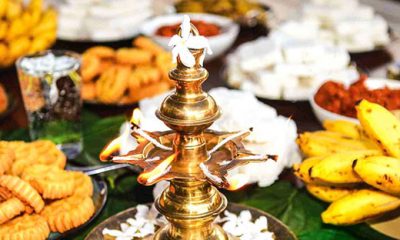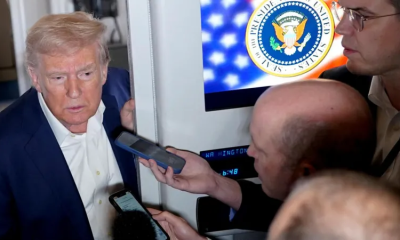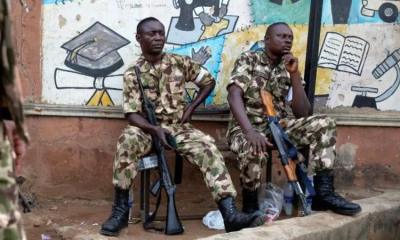Sports
Jailbreak for Kings XI Punjab, choke for Sunrisers Hyderabad
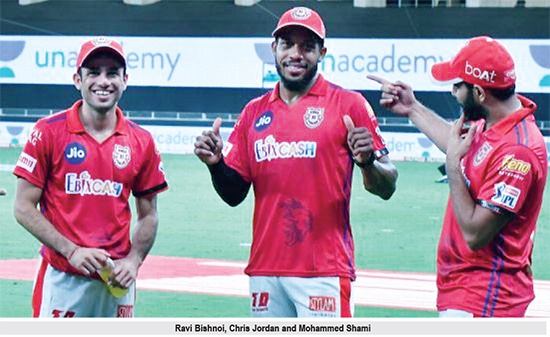
The Kolkata Knight Riders thumped the Delhi Capitals earlier on Saturday to consolidate their fourth spot and establish a four-point lead over the Sunrisers Hyderabad and the Kings XI Punjab. In the Sunrisers’ previous game against the Rajasthan Royals, the middle order bailed them out after both David Warner and Jonny Bairstow fell cheaply. However, they unravelled spectacularly on Saturday as the Kings XI pulled off an unlikely heist. Here’s how it unfolded
56 for 1
In pursuit of a modest target of 127, the “old-school” Warner turns up and takes on the Kings XI’s gun bowler Mohammed Shami. The Sunrisers’ captain lofts Shami over cover for six, then flat-bats him over his head and pulls him past mid-on for fours. All up, Warner scores 22 runs off 13 balls from Shami. The Sunrisers are 52 for 0 in six overs.
Enter Ravi Bishnoi. Exit Warner. Having reverse-swept a googly for four first ball, Warner aims another reverse-sweep off the second, but Bishnoi finds more turn and bounce. The ball flicks Warner’s glove and Rahul hangs on to a catch. Paul Reiffel, the on-field umpire, though shoots down the appeal, which Rahul reviews successfully to overturn the on-field not-out decision. Warner gone for a rapid 35.
58 for 2
M Ashwin had harried Bairstow with googlies in his first two overs. Ashwin, like fellow legspinner Bishnoi, relishes bowling the googly more than the legbreak. It was the same variation that impressed Stephen Fleming and MS Dhoni so much that they shelled out INR 4.5 crore in the 2016 auction to get him on board at the Rising Pune Supergiant.
In the past couple of seasons, Ashwin has got the googly to skid off the pitch. Bairstow is ready for the googly in Ashwin’s third over. He shapes to sweep with the break through square leg. However, Ashwin gets a legbreak to drift into Bairstow and bowls him around his legs.
67 for 3
Manish Pandey is taking his time to settle as the Dubai pitch is slowing down. Abdul Samad is promoted to No.4 to perhaps target the bowlers and shorter boundaries. Or perhaps the Sunrisers just don’t want to risk Vijay Shankar, who had hurt his thumb in the field, in a small chase. Shankar had suffered back spasms earlier in the tournament as well.
Rahul searches for another breakthrough and brings back Shami. The Kings XI’s main bowler will finish his quota by the ninth over. Another batsman may have opted to see Shami off, but Samad is a six-hitter, and that’s why he has been picked ahead of Abhishek Sharma.
Shami pitches it right in the slot, but Samad doesn’t quite get underneath the length and feebly chips it to mid-off, where Chris Jordan pouches the overhead catch. The Kings XI start to believe.
100 for 4
Pandey and Shankar threaten to close out a second successive chase. They work past the early blows by dropping the ball into the gaps. Pandey, in particular, struggles to read Bishnoi’s googly and so once Jordan comes back, he looks to chance his arm. He swishes at a leg-side full-toss and misses.
Jordan then shifts his line outside off, but overpitches it. Pandey, like Samad, doesn’t quite get under it, and chips it in the air. J Suchith, the sub fielder, tears across to his right, and plucks a catch out of thin air in front of the Kings XI dugout.
In the 2017 IPL final, Suchith had ran out Washington Sundar off the last ball as a sub fielder to seal a one-run win for the Mumbai Indians. Pandey’s grab will turn out to be a match-winning fielding effort as well.
Ravi Bishnoi, Chris Jordan and Mohammed Shami – the heart of KXIP’s bowling BCCI
The Sunrisers need 27 off 23 balls.
110 for 5
All of the Sunrisers’ hopes are on Shankar. He had lined up his Tamil Nadu team-mate Ashwin and driven him straight for a brace of fours. Then, there was a languid lofted drive over mid-off for four off Jordan. After that boundary, the Sunrisers need only 20 off 18 balls. At that stage, ESPNcricinfo’s forecaster pegged Kings XI’s chances at a mere 5.47%.
Jason Holder jabs Arshdeep Singh to point and Shankar responds for the single, taking on Nicholas Pooran’s arm. Pooran misses the stumps, but Shankar cops a nasty blow on the grille of his helmet as the ball skids off the turf and bounces extra. After the Sunrisers’ medical staff tend to Shankar, he composes himself and signals that he’s ready to bat on.
Shankar wants to finish back-to-back games for the Sunrisers. He expects a short delivery and ventures leg side, hoping to manipulate the gap between backward point and short third man. Singh keeps it short, but it’s an off-pace cutter that grips and has Shankar edging behind to Rahul.
It comes down to the Sunrisers
needing 17 off 12 balls.
112 for 6
Jordan v Holder. The Kings XI’s seniors Rahul, Chris Gayle, Glenn Maxwell, and Pooran are all part of an intense discussion with Jordan. He will be bowling into Big Jase from over the wicket, with the leg-side boundary being the shorter one. Arshdeep will have the cushion of bowling of the last over, with the leg-side boundary being the bigger one.
Jordan brings him with him the reputation of being a bonafide death bowler for England, but he hasn’t quite had his IPL moment. That Super Over against the Mumbai Indians could’ve gone awry for him if not for Mayank Agarwal’s stunning save at the boundary.
Arshdeep Singh celebrates after a key strike BCCI
Agarwal is out injured now, but Jordan has a chance to stamp his authority on the IPL. His first ball is a middle-stump yorker and Holder stabs it down to long-on for one. Priyam Garg squeezes a single off the second to bring Holder back on strike. Jordan’s plan is simple: hide the ball away from Holder’s reach and deny him access to the shorter leg-side fence. Jordan executes his plan and has Holder carving a catch to Mandeep Singh at extra-cover.
Mandeep had lost his father on Friday evening, but here he is stepping up under pressure for the Kings XI.
112 for 7
The Sunrisers need 15 off nine balls. They need more magic from Rashid Khan after he had ripped out Rahul with a perfect wrong’un earlier in the evening. Jordan goes wide of off once again, and Khan only scythes it straight to Pooran at sweeper cover for a golden duck. Double-wicket penultimate over. Four years after having been yanked out of Sky Sports’ panel of IPL analysts as a late replacement for the Royal Challengers Bangalore, Jordan has his IPL moment. It’s panic stations for the Sunrisers.
114 for 8
Arshdeep has 13 to defend to pull off a coup. He has only played three first-class and 18 white-ball games for Punjab in domestic cricket. He is up against Sandeep Sharma, his senior state mate, who is Sunrisers’ swing bowler in the IPL. Sunrisers need him to swing with the bat now. Arshdeep, however, digs in an offcutter and has Sharma splicing a pull to midwicket.
114 for 9
Garg has crossed over and the Sunrisers need 13 off four balls. He’s probably wondering how it came down to this? Arshdeep digs in another cutter at off stump and dares Garg to manufacture pace for himself. However, the batsman is cramped for room and only drags it to long-on, where Jordan runs in, dives forward, and snaps up another smart catch.
114 all out
With the game up, Arshdeep gets another cutter to stick in the pitch, drawing a weak push from No.11 Khaleel Ahmed to point. Ahmed simply dawdles for the single and is emphatically beaten by a direct hit from Bishnoi. It raises his coach Anil Kumble off his seat and even has him applauding animatedly.
From having lost games from seemingly winning positions, the Kings XI pulled off a great escape to secure their fourth victory in a row, boosting their playoffs chances. As for the Sunrisers, they’re still not out yet, but how will they recover from such a cataclysmic collapse? (ESPN)
Sports
Lankan legends, Modi and the Jaffna dream
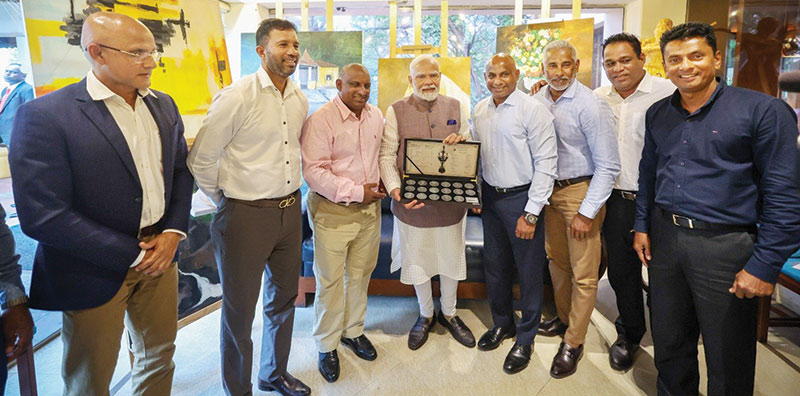
Tamil Members of Parliament with roots across the Palk Strait are often quick to look towards India at the drop of a hat. But last week, all they managed was a photo op with Indian Prime Minister Narendra Modi – smiles, handshakes and little else. In contrast, Sri Lanka’s 1996 World Cup-winning cricket team was granted a 45-minute chinwag over tea with the Indian leader. The Indian High Commission in Colombo had arranged the meeting. Not even former President Ranil Wickremesinghe, with all his so-called diplomatic finesse, has managed to get a similar audience.
Pictures of Modi rubbing shoulders with Sanath Jayasuriya and Aravinda de Silva went viral in India on social media and it was the talking point across news channels and print media as well. And why not? Not since the marauding days of Sir Vivian Richards have Indian bowlers been sent on a leather hunt quite like they were by these two Sri Lankan giants. It was déjà vu for Indian fans – memories of the Wills World Cup semi-final at Eden Gardens, still fresh like an old wound that refuses to heal.
During the meeting, Jayasuriya pitched an idea to the Indian PM – seeking help to build a cricket stadium in Jaffna. It wasn’t a doosra out of nowhere. There’s a deep and genuine passion for cricket in the north. Some of the school big matches in the region have stood the test of time, with legacies stretching back over a century. Yet, due to decades of conflict, the region has remained a barren patch in terms of producing top-tier cricketing talent.
Since the guns fell silent, though, there’s been a fresh crop of hopefuls from the north. Leading the charge is leg-spinner Vijayakanth Viyaskanth – a name that’s now turning heads. Though his First-Class stats are more than decent, Viyaskanth has chosen the glitz and glamour of franchise cricket, where the pay cheques are fatter and the schedule less grueling.
Behind the scenes, Sri Lanka Cricket’s (SLC) District and Provincial coaches have done a stellar job, scouting and grooming pace bowlers and other youngsters from these long-neglected areas. Some of these boys have gone on to wear the Under-19 jersey with pride – a sign that the talent pool is slowly, but surely, filling up.
However, SLC’s grand vision of building new stadiums to attract larger crowds has hit a few bumps. The old guard – some former greats – have been quick to swing the bat in criticism. They’ve taken their eye off the ball, failing to see the bigger picture. Take next year’s T20 World Cup, for instance. Co-hosted by Sri Lanka and India, it promises to be a blockbuster. The high-voltage India – Pakistan clash is set to take place in Colombo, with the R. Premadasa Stadium’s 35,000 seats expected to vanish like isso vade at the Galle Face green. A bigger venue – like the proposed facility in Homagama – would have been just the ticket to meet such mammoth demand.
But Sanath’s plea is in a different league altogether. He’s not asking for a behemoth like Eden Gardens or the Narendra Modi Stadium in Ahmedabad. His is a humble request – a ground with decent infrastructure and floodlights that can host day-night matches. A facility like that would be a game-changer for the north, a true shot in the arm. Nothing ignites a young cricketer’s imagination more than watching their heroes up close, not through a television screen but under the stars, in their own backyard.
At present, the closest international venue to Jaffna is in Dambulla—hardly accessible, especially for aspiring fans and players from the peninsula. A ground in Jaffna would not only bridge that distance but also build a bridge of hope and opportunity.
Back in 2002, when Janashakthi opened a branch in Jaffna, the great Muttiah Muralitharan made the long road trip to play a friendly match on a matting wicket. The welcome he received was nothing short of electric. The crowd adored him, showering him with affection that could rival the warmth of any southern stand.
Since then, we’ve hardly scratched the surface when it comes to understanding the region’s cricketing appetite. If the Indian government lends an ear to Sanath’s appeal, we might just discover a goldmine of talent waiting to be unearthed in the north. Who knows? The next Murali or Malinga might be bowling on a dusty street in Jaffna this very moment – waiting for a stage, a spotlight, and a bit of help from across the Palk Strait.
by Rex Clementine
Sports
Sri Sumangala’s cricketing miracle
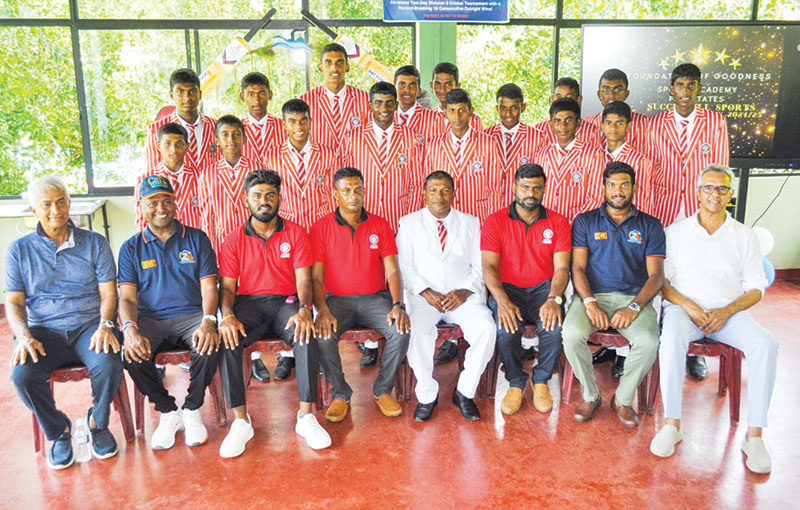
Sri Sumangala Vidyalaya, Hikkaduwa has scripted a fairytale rise in school cricket, marking a monumental milestone just 18 years after forming its first team. Once deprived of even a proper ground, the school now proudly boasts an unbeaten Under-19 team that has clinched both the Division III two-day and one-day championships — a rare double that has earned them promotion to Division 2.
The turnaround began in 2007 when the Marylebone Cricket Club (MCC) helped establish the Sri Sumangala MCC Lord’s Cricket Grounds following the devastating tsunami. This facility, offered free of charge, became a beacon for young cricketers who had talent but lacked opportunity. What followed is nothing short of a sporting miracle: 16 consecutive outright wins by the U19 team and national recognition in school cricket circuits.
This isn’t just a story of trophies and titles — it’s about breaking generational barriers. These young cricketers, once trapped in a cycle of poverty and obscurity, now inspire their community and set benchmarks for others in rural Sri Lanka.
The MCC’s early investment has borne fruit, turning dreams into tangible success. Today, the legacy of Lord’s lives not only in London but also in the hearts of the aspiring cricketers of Hikkaduwa — proof that when given a chance, talent can indeed take flight.
Foundation of Goodness has been a beacon of hope for sporting talents in the region and representation for Sri Lanka Women’s Under-19 team has been dominated by them. The same could happen with the men’s team in the near future.
Sports
St. Sebastian’s back on the basketball track
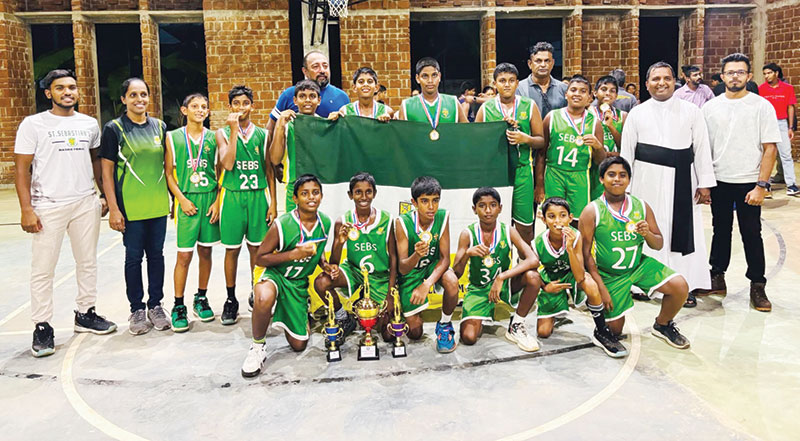
In the bygone years it was the Colombo schools that dominated basketball in Sri Lanka. Bens under Ram Sunderalingam, Peterites coached by Naufer Mahroof and the Josephians shaped by Mahadevan were the trojans who won tournaments. Led by this trio and flanked by other basketball playing schools in the capital, the game had its foundation laid down in concrete – Colombo style.
Moratuwa and Batticaloa were the painful thorns amidst the Colombo teams when it came to championships. And Trinco was the dark horse, almost unbeatable in their heyday, playing under the wizard, late Father Eugene Herbert. This is what basketball was, beginning from the sixties.
Today the faded memories remain. On a lucky day one might meet Doc Thurai, as he was popularly known, walking his wards with the stethoscope round his neck. He was the best we saw in that era. If one visits Batticaloa there is a prominent statue outside the town. It is of a tall Jesuit Priest. Here, he cradles a Wilson basketball ready to take a ‘time-out’ and yell at the referee. That is Father Herbert, the man who filled the Eastern Province with stellar players who left their luminous mark in the basketball courts of Sri Lanka.
More recently in April, on the 6th Sunday, I watched the under 13 ‘B’ division basketball finals between St. Sebastian’s and St. Thomas’ Prep. It was played at a flood-lit indoor court in Moratuwa. No, it certainly wasn’t in the league of Madison Square Garden, but it was more than adequate for a schools’ final. I sat on a wooden bench and watched the match thanking the court creator Sugath Thevarapperuma. I must mention this former national player who is doing yeomen service to promote basketball by establishing indoor courts in different locations.
Back to the match. It was good and exciting and the Sebastians won 37-36 by a solitary point. This was great for Moratuwa and the school and the young players. This victory would awaken the school and the basketballers from the doldrums they had been mired for a considerable time to say ;we are coming back’.
This 1-point victory I witnessed appeared to me as a catalyst for greater performances and perhaps an eye-opener for the Moratuwa lads. They are indeed capable of leaping bigger steps to reach higher pedestals in schools’ basketball championships. Yes, that is an achievable possibility, and the need is to change gears and go for the over-drive.
It is time for St Sebastian’s to forget the apathetic era and the reasons for such, and forge ahead with renewed motivation to re-claim former glories with their current potential.
The Thomians fought to the end. They certainly were equal in spirit and determination to become the champions. The difference was simply 1 solitary point. The pattern of play was the same by both teams and the award for the best player went to Akash Wijesinghe and Amantha Hettiarachchi was adjudged the best guard.
I noticed that some new rules have been introduced to control the game. The teams are only allowed to play ‘man-to-man’ and they could do so only from the center line. Additionally, the coach cannot use a double guard on the opposing best player. The teams are not allowed to use a zonal defense or play a floating man to man. If these rules came from FIBA then there is no argument. But if it is a local ramification of rules of how the game should be played, I have to humbly say that this will be a significant deterrent to coaches and players and a recurring headache to the referees. Over to you Sir, the Head of the Schools’ Basketball Association.
For me personally, it was an ‘Alma Mater delight’ to notice that the two coaches of the playing teams were both from St Sebastians and the assistant coach too was from my old school. Chaminda de Alwis and Susil Dias coached St. Sebastian’s and Isuru Perera the Thomians.
Chaminda captained the national team and Isuru had Ceylon Basketball colours and Susil represented All Island Schools.
Yes, St. Sebastian’s had a lot of glory days in basketball. Many of their players represented and captained the national team. Then one might ask, “how come they hit rock bottom playing a game they more or less dominated?”
The answer is simple, I will leave it for another day to elaborate.
On second thoughts, some things are best left unsaid.
by Capt. Elmo Jayawardena
elmojay1@gmail.com
-

 Business7 days ago
Business7 days agoColombo Coffee wins coveted management awards
-

 News2 days ago
News2 days agoSuspect injured in police shooting hospitalised
-

 Features3 days ago
Features3 days agoRobbers and Wreckers
-

 Features5 days ago
Features5 days agoSri Lanka’s Foreign Policy amid Geopolitical Transformations: 1990-2024 – Part III
-

 Midweek Review5 days ago
Midweek Review5 days agoInequality is killing the Middle Class
-

 Features7 days ago
Features7 days agoSri Lanka’s Foreign Policy amid Geopolitical Transformations: 1990-2024 – Part I
-

 Business2 days ago
Business2 days agoSanjiv Hulugalle appointed CEO and General Manager of Cinnamon Life at City of Dreams Sri Lanka
-

 Features6 days ago
Features6 days agoA brighter future …




